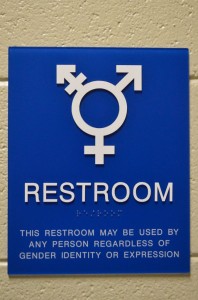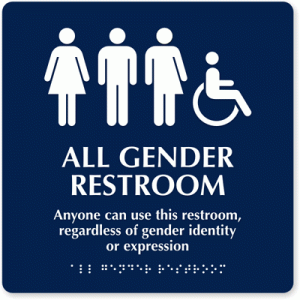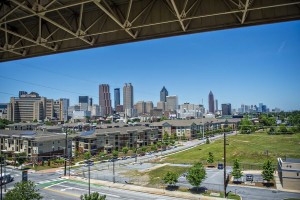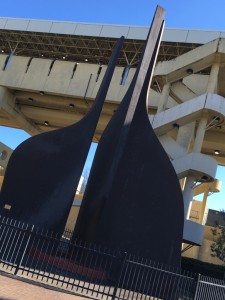When first approaching the diner, you are greeted with the famous symbolic neon Landmark diner sign. Despite the sign being quit old and run down, as evident in some of the burnt out neon letters on the front, the sign still gives off an invitational vibe for authentically cooked diner food.
Author Archives: Kevin Duong
Annotated Bibliography 6
Cottrell, Megan. “Libraries Move Toward Gender-Neutral Bathrooms.” American Libraries46.11/12 (2015): 16-17. Consumer Health Complete – EBSCOhost. Web. 21 Feb. 2016.
In this article, Megan Cottrell describe how public libraries are making a move towards gend er-neutral bathrooms. Liberians everywhere work to ensure that their collection and programs offer members of their community a safe place, therefore some libraries today are including bathrooms that accommodate to the transgender or the gender nonconforming. Surveys show that transgender people often experience discrimination in restrooms, such as being stared at, ridiculed, told to leave, or not allowed to use the facilities; even physical violence or having the police called. The article gives an example of Portland Community College, Oregon’s largest post-secondary institution, who has taken on the issues of gender-neutral restrooms and has received a lot of positive feedback; both from the transgender community as well as other students who appreciate the privacy of 22 new all-gender bathrooms. While this is an issue for libraries building new spaces, others are figuring out ways to make patrons comfortable with their existing facilities, which also raises many different issues. Overall as society moves towards a more transgender accepting society, libraries need to serve those particular patron, have a safe place that welcomes them without judgment.
er-neutral bathrooms. Liberians everywhere work to ensure that their collection and programs offer members of their community a safe place, therefore some libraries today are including bathrooms that accommodate to the transgender or the gender nonconforming. Surveys show that transgender people often experience discrimination in restrooms, such as being stared at, ridiculed, told to leave, or not allowed to use the facilities; even physical violence or having the police called. The article gives an example of Portland Community College, Oregon’s largest post-secondary institution, who has taken on the issues of gender-neutral restrooms and has received a lot of positive feedback; both from the transgender community as well as other students who appreciate the privacy of 22 new all-gender bathrooms. While this is an issue for libraries building new spaces, others are figuring out ways to make patrons comfortable with their existing facilities, which also raises many different issues. Overall as society moves towards a more transgender accepting society, libraries need to serve those particular patron, have a safe place that welcomes them without judgment.
I chose this source because it further discusses gender-neutral bathrooms in a specific place, libraries. A flaw in this essay is that it provides a solution and evidence to gender-neutral bathrooms but only account for bathrooms in school libraries.
Annotated Bibliography 5
Felsenthal, Kim D. “Creating The Queendom: A Lens On Transy House.” Home Cultures 6.3 (2009): 243-260. Art & Architecture Complete. Web. 21 Feb. 2016.
 In this study, Kim D. Felsenthal explores the unique landscape of Transy Houses (transcape) and the person and place interaction within them. Transy houses is a trans-dominated communal house where residents control a defined socio-spatial territory. In her research, Felsenthal raises the issue on how there is little space in physical geography where trans persons can safely be who they are without fear of homophobic or transphobic violence. She explains how a transgender home is a place were they self identify and serve as multifunctional platform for everyday common use. The study shows how there are unique differences in each room of a Transy House, each having their own design and furnishing specific to that individual. In shared areas, you can see a collective identity is formed when attributes of one’s own characteristics and self-identification merge with that of the larger group with which one is associated. Kim Felsenthal explains how transcape provide the gay, lesbian, bisexual, transgender, queer/questioning (GLBTQ) communities; a private place where they are empowered to make their own trans-normative rules for behavior and gender expression. Additionally, occupants have opportunities to manipulate the physical environment to exhibit and fortify their trans identities away from norms and values of mainstream society.
In this study, Kim D. Felsenthal explores the unique landscape of Transy Houses (transcape) and the person and place interaction within them. Transy houses is a trans-dominated communal house where residents control a defined socio-spatial territory. In her research, Felsenthal raises the issue on how there is little space in physical geography where trans persons can safely be who they are without fear of homophobic or transphobic violence. She explains how a transgender home is a place were they self identify and serve as multifunctional platform for everyday common use. The study shows how there are unique differences in each room of a Transy House, each having their own design and furnishing specific to that individual. In shared areas, you can see a collective identity is formed when attributes of one’s own characteristics and self-identification merge with that of the larger group with which one is associated. Kim Felsenthal explains how transcape provide the gay, lesbian, bisexual, transgender, queer/questioning (GLBTQ) communities; a private place where they are empowered to make their own trans-normative rules for behavior and gender expression. Additionally, occupants have opportunities to manipulate the physical environment to exhibit and fortify their trans identities away from norms and values of mainstream society.
I chose this source because it explores and gives more of a understanding to the LGBT community.
Annotated Bibliography 4
Pickerill, Jenny. “Who Builds The Houses?.” Communities 162 (2014): 20. Advanced Placement Source. Web. 21 Feb. 2016.
In Jenny Pickerill’s article, she studies men and women involvement in the building of eco-communities and the struggle to overcome gender inequality. Pickerill explains how she has been researching and working with eco-communities for the last decade, in her studies she focuses on how houses in eco-communities get built, the decisions, choices, and dilemmas involved, the costs, the compromises, and how the completed house is lived in, works, and functions. Despite the feminist movement in the last century, eco-communities still experience gender inequality when it comes to building and living. Throughout her travels, Pickerill explains how females in general are socially stereotyped to primarily have and raise a family, in doing so they are expected to spend their time doing domestic chores. Pickerill then translates this into female eco-builders who are viewed as being weaker than men therefore they cannot be good builders. She rebuttals this by stating that building doesn’t require strength alone but creativity and communication; things men and women can do. Jenny Pickerrill concludes her argument by stating that we need to embrace gender as a form of diversity, but not as a division of labor. We need to create space for women to build and to acknowledge the work that many women already do on build sites. To women’s contributions visible and valued.
I chose this source because it relates to the topic of this unit on gender equality. This source can be compared to the issues brought up in LGBT equality.
Reading Summary 4
 The most distinct and clearest visual marker that separates male and female are the signs on public bathroom entrances. Having Men on one door and Women on the other; people in society have to choose what gender they are every time before they enter a bathroom. In this new generation gender equality is slowly being adopted in all aspects of life in society. But restrooms being a public convince, freely available in most places and are open to all; are still a place where gender is separated. Restrooms are ultimately where we as humans go and obey the dictates of our bodies, therefore it is natural to feel vulnerable. Due to this, humans have created a standard were when someone confuses male and female and walk through the wrong door, that person risks discomfort or even real trouble. But now transgender people are asking society to rethink this old convention of signs.
The most distinct and clearest visual marker that separates male and female are the signs on public bathroom entrances. Having Men on one door and Women on the other; people in society have to choose what gender they are every time before they enter a bathroom. In this new generation gender equality is slowly being adopted in all aspects of life in society. But restrooms being a public convince, freely available in most places and are open to all; are still a place where gender is separated. Restrooms are ultimately where we as humans go and obey the dictates of our bodies, therefore it is natural to feel vulnerable. Due to this, humans have created a standard were when someone confuses male and female and walk through the wrong door, that person risks discomfort or even real trouble. But now transgender people are asking society to rethink this old convention of signs.
The world is not yet ready to idea of mixing male and female anatomy in multistall bathrooms and locker rooms. As evident in in the voters rejection of a broad equal rights ordinance in Houston. This law would have protected individuals against discrimination in housing and employment, as well as public spaces, on the basis of several categories, including age and race along with sexual orientation and gender identity. The opponents won , by nicknaming the law the “bathroom ordinance” also making a t-shirt and TV ad showing a sinister man threatening a girl in the stall, as a result successfully instilling fear in the voters.
 In contrary to Houston recent rejection for gender equality bathrooms. School districts have been generally accepting to transgender student. Transgender students are call by their preferred names and are allowed to join the sports teams of the gender with which they identify with. On the other handing, deciding where they should change and shower and use the bathroom has been more pragmatic. A great example would be a case in suburban Illinois, where a transgender high school student that underwent hormone therapy and passport identified her as female, asked to change in the girls’ locker room. The district refused and had her change in a separate room down the hall. She and her parents ordered a civil rights complaint to the the United States Department of Education. The Education Department granted her the right to change and shower in the same locker room as her female peers; a curtain addressed all her needs and other students’ concerns. It was just that simple to give a transgendered high school student the comfortability she needed to shower and change at school.
In contrary to Houston recent rejection for gender equality bathrooms. School districts have been generally accepting to transgender student. Transgender students are call by their preferred names and are allowed to join the sports teams of the gender with which they identify with. On the other handing, deciding where they should change and shower and use the bathroom has been more pragmatic. A great example would be a case in suburban Illinois, where a transgender high school student that underwent hormone therapy and passport identified her as female, asked to change in the girls’ locker room. The district refused and had her change in a separate room down the hall. She and her parents ordered a civil rights complaint to the the United States Department of Education. The Education Department granted her the right to change and shower in the same locker room as her female peers; a curtain addressed all her needs and other students’ concerns. It was just that simple to give a transgendered high school student the comfortability she needed to shower and change at school.
The main goal in creating public bathrooms that are open to all genders is accommodation. Accommodation is a word that implies moving over to make room for others, whether you want it or not. Society have been able to provide reasonable accommodations for people with disabilities, by putting a bar next to a toilet and a button that opens the door. Why can’t a transgender shower in their own stall amongst her peer by just providing them with a privacy curtain. A small adjustment for the sake of coexistence.
As we approach the future and more transgender people are able to use the bathroom of their choosing. The Transgender Law Center offers a resource guides that help transgenders go to the bathroom they identify with. Having a public bathrooms that accommodate to transgenders means that the place must allow that person to feel comfortable and be able to belong, something all us human need.
Reading Summary 3
In this current era the definition of gender has transformed, no longer does it have a clear role in separating male and female. Through todays advances in technology, traditional masculine and feminine roles are being challenged. Designers of today need recognize society’s issues in todays gender revolution, being able to work and help promote a more accepting and diverse society.
The main issue currently with gender is that the design within todays landscape is still upheld by Modernism, an architectural movement built in the male’s perspective. In the past men have seized all power in the workplace, as a result male necessities are met through Modernist design models, leaving females with subsequent accommodations. Even in today’s information age, the world of technology and web design is also a very male-dominated field, with 85 percent of tech workers at the top companies being male.
Though recently there have been events pointing to a new wave of feminism. Emma Watson, an actress and UN Women Goodwill Ambassador, gave a speech promoting the He for She movement went viral, which promoted men to join the cause for gender equality. The LGBTQ rights movement is also gradually accepting same-sex marriage. In the workplace, woman have become more prominent, therefore today’s workplace is going through a transformation. People want mire softness in interiors with the influences of hospitality through tactile and textural materials like carpeting and textiles. The time for designers to modify gender sensitivity into their work is now.
When you are born, typically you are assigned a gender, but you can decided what gender to identify with beyond this. In this present day, college students are not putting their gender down in forms and children in middle school are asking to have their gender unspecified or changed. This is showing that the up and coming generation are taking a stand and saying they don’t want to be identified a one or the other (male or female).
Architecture and interior design are slow in the process to gender equality, compared to the world of fashion and beauty. Because of their fast cycles they are the first to embrace the trends of this new generation. For example, Alexander Wang’s women’s coat from Fall 2015 has masculine tailoring with a military look and Annemiek van der Beek’s Primal Skin makeup line has been designed to be appealing to the male buyer.
Corporations like Google have taken note of this new gender neutral revolution, and have adopted unisex bathrooms to allow all individuals in the workplace to feel comfortable, safe, and included. Martine Rothblatt, a transgender who is the CEO of United Therapeutics, defied traditional roles by becoming the highest-pad female executive in the Untied States even though she was born biologically male. But in many businesses there is still issues with sexuality. In one case, an employee underwent gender-reassignment surgery during summer break, but on his return both female and male coworkers went to human resources and complained about not wanting this person in their bathroom.
In the past, being male meant that you were the dominate force over females, but in the post-gender world of today masculine and feminine roles are being switched and obscured. This is an essential human phenomenon and in this society design needs to be respectful to every different individual. In being able to create an environment were a gender-neutral design accommodates to everyone’s need, then anybody can function and do what they need to do no matter who they are, all in a safe place.
Mid-term Reflection (Draft)
As we are coming up to the mid-term of the semester, after completing the three required projects (Reading Summaries, Annotated Bibliography, and Built Environment Description), I feel that my research and writing skills have changed. Before in other English and writing class, I am often given a subject to research and write about, but in this class I am given a lot more freedom when choosing a subject in my writing. Since I am not quit use to having the ability to choose what my subject of a project may be, it is hard sometimes to make a decision on what to write about. Although it has made me realize that research is important before the writing process can be done. Having done the three project, I have discovered that a lot of information can be obtained specifically and exclusively through either primary or secondary research. The Reading Summary has sharpened my analysis skills, the Annotated Bibliography has improved my research skills, and the Built Environment Description helped me applied what I saw in reality on to paper more clearly and distinctly. I plan on using what I’ve learn form these first projects and applying them to future projects. As I continue to attend class and work on the projects, I have come to see that all the students’ projects in the class are slowly becoming an archive of the built environment. I believe my peers and the audience outside of this class are viewing my post in hopes of getting a better understanding of the built environment under discussion. Enabling the students to be able to perform their writing on a blog, gives way to a lot more creative possibilities. By having the class on a integrated platform, students are able to share and get inspiration for their writing through other students in the class…….
Exterior Built Environment Description: King Memorial Station
 The King Memorial Station is one of the seven Marta stations completed in 1979. The station was built to commemorate the memory of Dr. Martin Luther King, Jr. and the first national holiday in his name. The station is located on Decatur Street SE and is on the blue and green line of the Marta railway. The architecture of the King Memorial station is unique compared to the other station on Marta. The train station is elevated above 21 Memorial Drive, aligned under-passing street were Marta buses and other forms of transportation come and go; the station itself provides protection for waiting passengers from everyday weather, such as rain. The stations is white/grey three stories high and is a combination of round rectangular sections. The building gives off a polished and smooth visual due to its rounded edges and sleek appearance. Upon entering the King Memorial station there are multiple stairs that lead up to the security gates. When enter the through security gates on the second floor, a long panel of glass windows on your right opens up a magnificent view of the city of Atlanta. From this view you would be able to see Grady Memorial Hospital, 191 Peachtree Tower, Promenade II, and most of the popular buildings located in the city. Above that is the third floor were the railway is located. The railway stop is long and wide open to space; a no skateboarding sign is posted near one of walls. The the design of the top floor roof is a triangular pattern of interconnected metal bars, giving way to a lot of natural light being able to come through. Some artifacts present on site worth mentioning is the silver panel with a inscription dedicating the site to Dr. Martin Luther King, Jr. and a huge sculpture located in the front of the train station. Marta classifies this station as a neighborhood station, being home for many Georgia State University students and local residents. Places of interest near the station would the King Memorial, Martin Luther King’s boyhood home, Village Theatre, and Oakland Cemetery. The community surrounding the King Memorial station has gone through a renaissance of sorts in the past few years, being home to a array of new apartments, townhouses, retail shops, and businesses that align themselves on Decatur Street. The station itself and the King Memorial located near it, gives dedication to one of histories greatest civil rights activist, providing travelers a chance to learn about King and achievements. The King Memorial Station itself despite being old, the area around it is every growing and evolving, with new businesses and residents moving in everyday. I predicted that area around the station will soon become a rich and thriving community.
The King Memorial Station is one of the seven Marta stations completed in 1979. The station was built to commemorate the memory of Dr. Martin Luther King, Jr. and the first national holiday in his name. The station is located on Decatur Street SE and is on the blue and green line of the Marta railway. The architecture of the King Memorial station is unique compared to the other station on Marta. The train station is elevated above 21 Memorial Drive, aligned under-passing street were Marta buses and other forms of transportation come and go; the station itself provides protection for waiting passengers from everyday weather, such as rain. The stations is white/grey three stories high and is a combination of round rectangular sections. The building gives off a polished and smooth visual due to its rounded edges and sleek appearance. Upon entering the King Memorial station there are multiple stairs that lead up to the security gates. When enter the through security gates on the second floor, a long panel of glass windows on your right opens up a magnificent view of the city of Atlanta. From this view you would be able to see Grady Memorial Hospital, 191 Peachtree Tower, Promenade II, and most of the popular buildings located in the city. Above that is the third floor were the railway is located. The railway stop is long and wide open to space; a no skateboarding sign is posted near one of walls. The the design of the top floor roof is a triangular pattern of interconnected metal bars, giving way to a lot of natural light being able to come through. Some artifacts present on site worth mentioning is the silver panel with a inscription dedicating the site to Dr. Martin Luther King, Jr. and a huge sculpture located in the front of the train station. Marta classifies this station as a neighborhood station, being home for many Georgia State University students and local residents. Places of interest near the station would the King Memorial, Martin Luther King’s boyhood home, Village Theatre, and Oakland Cemetery. The community surrounding the King Memorial station has gone through a renaissance of sorts in the past few years, being home to a array of new apartments, townhouses, retail shops, and businesses that align themselves on Decatur Street. The station itself and the King Memorial located near it, gives dedication to one of histories greatest civil rights activist, providing travelers a chance to learn about King and achievements. The King Memorial Station itself despite being old, the area around it is every growing and evolving, with new businesses and residents moving in everyday. I predicted that area around the station will soon become a rich and thriving community.
Exterior Built Environment: Digital Record 6
In front of the King Memorial station to the far right there is a gigantic sculpture situated beside the intersection of Decatur Street and Grant Street. The sculpture is separated into three black metallic panels that transition into a point on top, each is placed centered around a central focal point were the points meet. Behind the sculpture is three fights of winding stairs that is closed of to the regular Marta traveler.
Exterior Built Environment: Digital Record 5
On the third and most top floor of the King Memorial station, is the Marta railway line itself. The King Memorial station railway is on the Marta blue line and is between Georgia state and Inman Park/Reynoldstown station. The railway stop stretches about 500 feet long across the railway. The railway stop is very atmospheric because of how wide and open to space it is. Huge openings on the side and ceilings provide the station with plenty of natural light. The entire ceiling is designed with metal bars interconnected in a triangular pattern providing a place were lights can be installed and a cool architectural feature.




